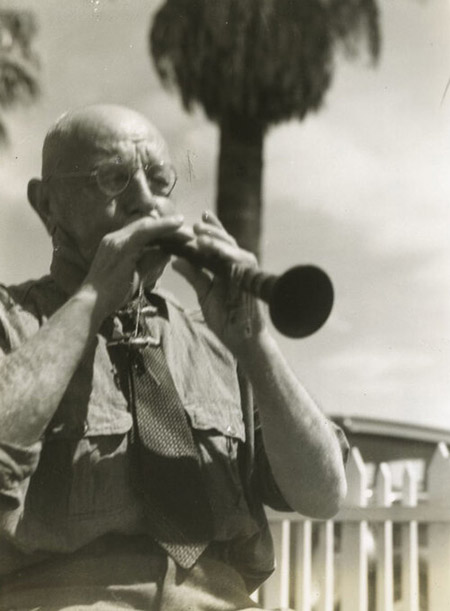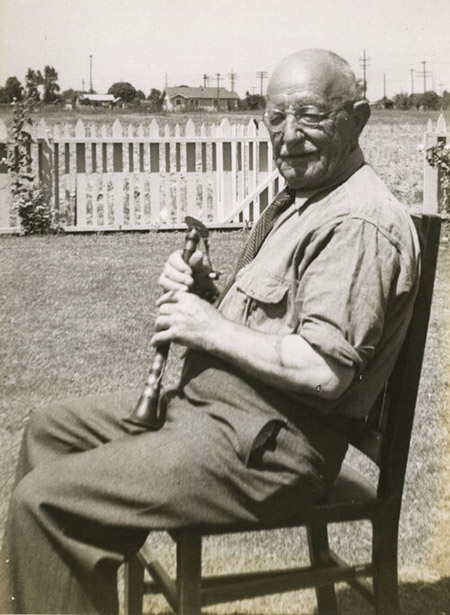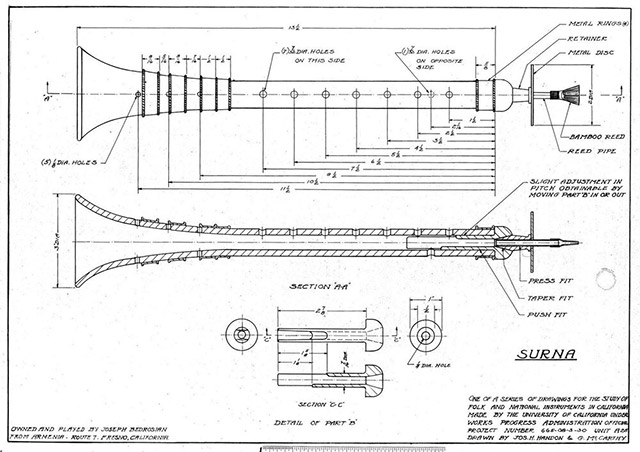On August 17, 1940 in the Central Valley of California, the Bedrosian family of musicians, led by Hovsep Joseph Bedrosian recorded four unique songs on the privately owned record label GME Records. The Armenian Museum of America’s Sound Archive celebrates these musicians and their contributions to recorded music.
It was a Saturday in the San Joaquin Valley of California, a typical weekend in the summer, the soil was hot and families had gathered in the farmlands of Fresno. On August 17, 1940, Hovsep Bedrosian was joined by his son Avedis and his cousin Bagdasar Bedrosian for a festive recording session. Much of the information related to these recordings is captured in the grooves of these discs as each song begins with a brief introduction by Avedis Bedrosian in Armenian and English. While Avedis is given the title of “director,” these recordings highlight the musical mastery found within Hovsep Bedrosian and his instrument, the zourna. During these sessions he was accompanied by his cousin Bagdasar on the davoul.
The zourna, a reed wind instrument, was not frequently recorded commercially in North America. Its relevance and importance are intertwined in the early Armenian-American experience with the most significant performer being virtuoso Hovsep Bedrosian. Born in Verin Khokh (Upper Khokh, a part of the village Khokh in the Southwest region of Kharpert which was known for its fine wines and davoul zourna players) in 1877, it’s very likely that Hovsep Bedrosian learned the instrument in his youthful days, before emigrating to the United States in 1893. Both Avedis ( born in 1901) and Bagdasar (born in 1893) were born in Verin Khokh. On these recordings presented with this article, the local accents from that specific region can be heard, making these recordings intriguing not only to music afficionados but also to linguists. It can be assumed that Hovsep Bedrosian returned to Verin Khokh at least once as his son Avedis was born after his first arrival in America. While Hovsep’s wife Youghaper joined him in America in 1907, interestingly, Avedis did not enter the United States until 1921. Avedis immigrated to the United States in 1913 via the Port of Providence.
While these self-produced recordings are the only known commercial recordings by Hovsep Joseph Bedrosian, it is quite possible that his performance career began much earlier. According to his granddaughter Jane Gamoian, a life-long performer of Armenian and Middle Eastern dance and currently the director of the dance group of the Temple dancers for Daughters of the Nile in Fresno, Joseph worked as a musician for an American circus company, P. T. Barnum. This is substantiated by the field notes of ethnographer Sidney Robertson Cowell. As part of the Workers Progress Administration during the New Deal, Sidney Robertson was responsible for the California Folk Music Project. On April 24, 1939 she recorded Hovsep “Joe” Bedrosian as well as numerous other Armenians from the Fresno area. The United States Library of Congress has the field recordings available and among her field notes is a quote by a Mr. Martin who says that the zourna is played in “all the best circuses!”
The zourna being a loud instrument was probably quite difficult to record. Thus, these songs may have been recorded outdoors, perhaps in a backyard or a barnhouse. Unfortunately those details are unknown. Throughout the four tunes, Avedis Bedrosian is constantly heard referencing people in attendance, interacting with the musicians and simply adding to the festive atmosphere. With disc GME #1 titled “Highleh” (or Haleh/ Halay- a dance) he informs us of the location, the date and the musicians. When we put the needle to the record (or in your case, you click on the file above) and the scratchy sounds dance through the speakers, a voice is heard. Avedis, the director of the session says:
“Aysor Okosdos dasne yote hazar ine hariur karasun, chaloghnere Hovsep yev Bagdasar Bedrosian…”
That’s how disc GME #1 begins. If it’s hard to understand, GME # 4 titled “Tamzara” might clear up the confusion for it begins in English:
According to the information provided on disc GME #2 titled “Eachayak” (which means three feet while the tune is a four step dance), a home recording device was provided by Dr. George Elgin, a resident of Chicago who frequently visited the Kandarian family in Fresno. As a matter of fact, for GME #3 the tune “Lavook” was recorded as a request by Markar Kandarian. Avedis, endearingly in his half-English half-Armenian says they couldn’t turn Markar down.
The short introductions that open each song are charming and unique ways to document the Armenian language. The variety of these tunes which are all dance numbers and the spectacular zourna playing of Hovsep “Joe” Bedrosian represent a dynamic musical culture and how the music from a village named Veri Khokh was transferred to the farmlands of Fresno, California.
Special thanks to Ms. Jane Gamoian for her assistance and support.



























































